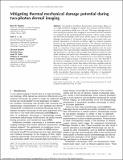| dc.contributor.author | Masters, Barry R. | |
| dc.contributor.author | So, Peter T. C. | |
| dc.contributor.author | Buehler, Christof | |
| dc.contributor.author | Barry, Nicholas | |
| dc.contributor.author | Sutin, Jason D. | |
| dc.contributor.author | Mantulin, William W. | |
| dc.contributor.author | Gratton, Enrico | |
| dc.date.accessioned | 2014-06-05T14:13:07Z | |
| dc.date.available | 2014-06-05T14:13:07Z | |
| dc.date.issued | 2004-10 | |
| dc.date.submitted | 2004-05 | |
| dc.identifier.issn | 10833668 | |
| dc.identifier.issn | 1560-2281 | |
| dc.identifier.uri | http://hdl.handle.net/1721.1/87643 | |
| dc.description.abstract | Two-photon excitation fluorescence microscopy allows in vivo high-resolution imaging of human skin structure and biochemistry with a penetration depth over 100 μm. The major damage mechanism during two-photon skin imaging is associated with the formation of cavitation at the epidermal-dermal junction, which results in thermal mechanical damage of the tissue. In this report, we verify that this damage mechanism is of thermal origin and is associated with one-photon absorption of infrared excitation light by melanin granules present in the epidermal-dermal junction. The thermal mechanical damage threshold for selected Caucasian skin specimens from a skin bank as a function of laser pulse energy and repetition rate has been determined. The experimentally established thermal mechanical damage threshold is consistent with a simple heat diffusion model for skin under femtosecond pulse laser illumination. Minimizing thermal mechanical damage is vital for the potential use of two-photon imaging in noninvasive optical biopsy of human skin in vivo. We describe a technique to mitigate specimen thermal mechanical damage based on the use of a laser pulse picker that reduces the laser repetition rate by selecting a fraction of pulses from a laser pulse train. Since the laser pulse picker decreases laser average power while maintaining laser pulse peak power, thermal mechanical damage can be minimized while two-photon fluorescence excitation efficiency is maximized. | en_US |
| dc.description.sponsorship | Unilever (Firm) | en_US |
| dc.description.sponsorship | National Institutes of Health (U.S.) (R33CA091354-01A1) | en_US |
| dc.description.sponsorship | National Institutes of Health (U.S.) (P41RR03155) | en_US |
| dc.language.iso | en_US | |
| dc.publisher | SPIE | en_US |
| dc.relation.isversionof | http://dx.doi.org/10.1117/1.1806135 | en_US |
| dc.rights | Article is made available in accordance with the publisher's policy and may be subject to US copyright law. Please refer to the publisher's site for terms of use. | en_US |
| dc.source | SPIE | en_US |
| dc.title | Mitigating thermal mechanical damage potential during two-photon dermal imaging | en_US |
| dc.type | Article | en_US |
| dc.identifier.citation | Masters, Barry R., Peter T. C. So, Christof Buehler, Nicholas Barry, Jason D. Sutin, William W. Mantulin, and Enrico Gratton. “Mitigating Thermal Mechanical Damage Potential During Two-Photon Dermal Imaging.” Journal of Biomedical Optics 9, no. 6 (2004): 1265. © 2004 Society of Photo-Optical Instrumentation Engineers | en_US |
| dc.contributor.department | Massachusetts Institute of Technology. Department of Biological Engineering | en_US |
| dc.contributor.department | Massachusetts Institute of Technology. Department of Mechanical Engineering | en_US |
| dc.contributor.mitauthor | So, Peter T. C. | en_US |
| dc.relation.journal | Journal of Biomedical Optics | en_US |
| dc.eprint.version | Final published version | en_US |
| dc.type.uri | http://purl.org/eprint/type/JournalArticle | en_US |
| eprint.status | http://purl.org/eprint/status/PeerReviewed | en_US |
| dspace.orderedauthors | Masters, Barry R.; So, Peter T. C.; Buehler, Christof; Barry, Nicholas; Sutin, Jason D.; Mantulin, William W.; Gratton, Enrico | en_US |
| dc.identifier.orcid | https://orcid.org/0000-0003-4698-6488 | |
| mit.license | PUBLISHER_POLICY | en_US |
| mit.metadata.status | Complete | |
